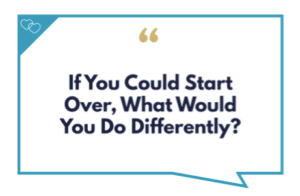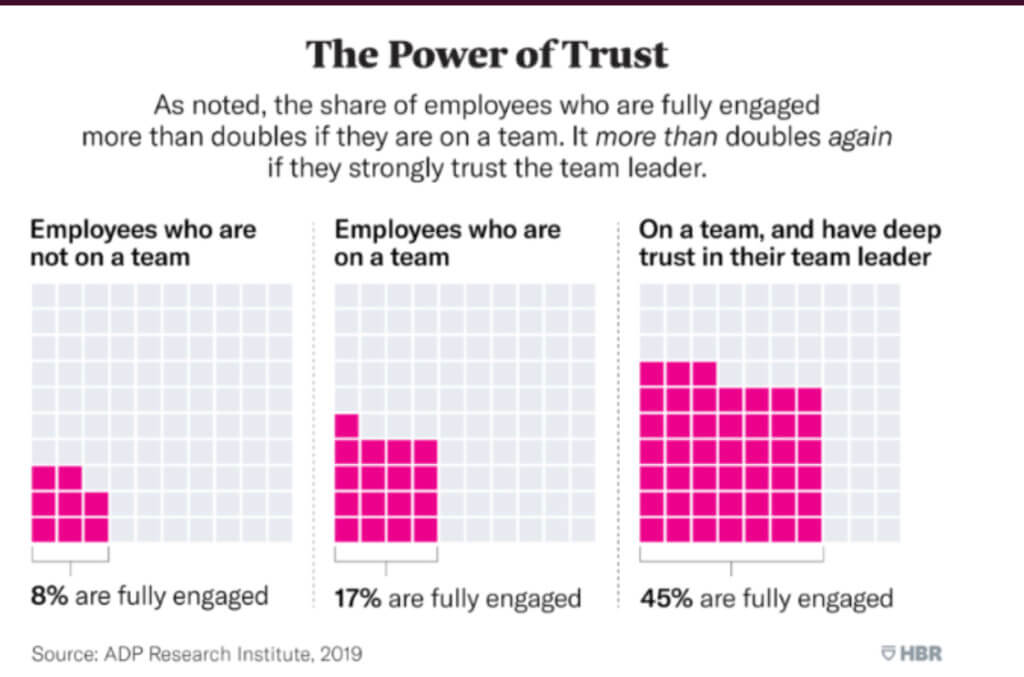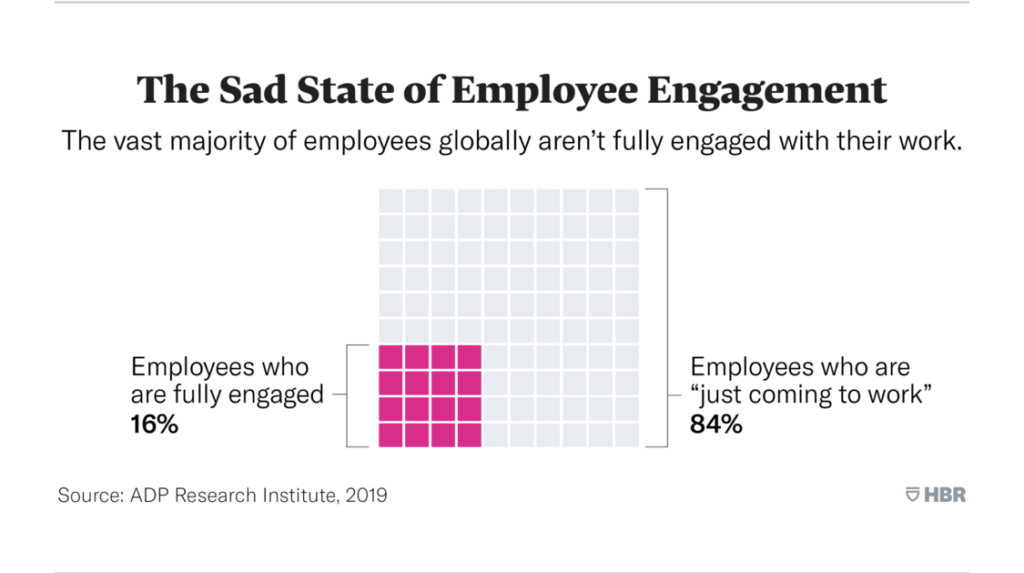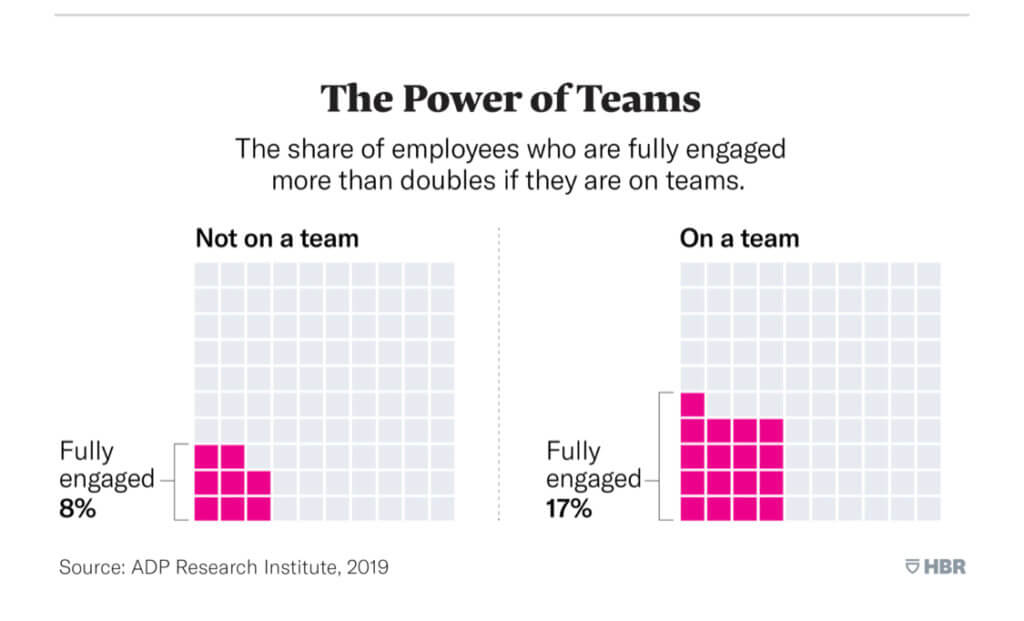by Jason Treu | May 22, 2019
Here’s a major reason companies are failing at employee engagement. ADPRI study states the most effective way to improve engagement is to focus on teams. #1 priority is to build “extreme” trust (lower levels of trust matter little).
“Team members who strongly agree that they trust their team leader are eight times as likely to be fully engaged as those who don’t. This trust must be deep and without question. A team member who merely agrees that she trusts her team leader shows roughly the same level of engagement as does someone who actively distrusts his team leader. For trust to matter, it must be extreme.”
https://hbr.org/cover-story/2019/05/the-power-of-hidden-teams
by Jason Treu | May 21, 2019

Would you wear a swimsuit in a blizzard? Would you wear a snowsuit if it was 110 degrees outside? Well, that’s what you are doing if you don’t do a “temperature check” at the start of your meetings.
Today, I’m going to share with you why you should do one and show you how it will increase engagement, productivity, and connection. You can share this with your other leaders in your organization, and look like a rockstar!
Being socially aware is absolutely critical to being an extraordinary leader. It means you understand the emotional landscape of the people around you (i.e. what’s driving their thoughts, behaviors, and feelings) and then adjust your communications and interactions with them. This is where empathy plays a huge role.
One place I see this go sideways for many leaders is in their 1:1 and group meetings. They come in with their agenda and goals, and they don’t consider where everyone’s mindset is at and how they are feeling. They operate like a runaway freight train…full steam ahead!
Ask yourself two questions:
- “When was the last meeting I ran where I knew with 99% certainty what was on the top of every person’s mind and how they were feeling at the start of the meeting?”
- “If I did know what everyone was thinking and feeling, what that help me run the meeting more effectively, get more engagement and accomplish more?”
If you answered either no or very rarely to question one, and yes to question two, then read on. This post will help you.
Here is why this matters to you:
- For example, if someone is really anxious because they have a big meeting coming and you try to hold a brainstorming meeting, they will most likely be checked out. They are rehearsing and preparing in their head that meeting.
A socially aware leader resets expectations of what can be accomplished depending on where people show up. If they don’t, they typically will end up frustrated, annoyed and/or think their team member(s) don’t care because they aren’t fully engaged. And this also negatively impacts the team because that person/people will think, “He or she doesn’t care and doesn’t get how I’m feeling or doing at this moment.”
Here is a play-by-play on how this can play out so you can visualize it:
- Joe (the team leader) starts off the meeting. “How is everyone doing today?” Joe doesn’t really care about what answer people give. He is just asking it because that’s what everyone does. Everyone says fine or some equivalent. Then they jump into the agenda and steamroll through it. Meanwhile, Jennifer is distracted because she just lost a big client. John is pumped up because he just closed three big deals in the last few days and can’t sit still. Joan is engaged because things are going well for her. Jeff is completely checked-out because his home life is a disaster and he is worried his wife is going to file for divorce. Joe is talking, but almost no one is really engaged. Then Jennifer, John, Joan and Jeff get together after the meeting at lunch and bitch and complain that Joe is a horrible leader and just “doesn’t get it.” Their negative emotions spread throughout the team (i.e. mirror neurons). They end up underperforming and reaching their peak performance potential.
Questions to ask yourself: How much do you really think got done in that meeting? Was it effective? What are the negative effects occurring? How much money did that cost to have that meeting in people’s time?
Is there is a different approach a leader could use to be more effective here? YES!
You can increase meeting productivity and avoid a lot of the downsides by starting off every meeting in a different way.
Your next question is, “how can I do do that?”
At the start of every meeting take a “temperature check to share their current personal weather conditions.”
It’s asking everyone the question, “How are you doing…REALLY? and WHY?”
Step 1:
- Each team member has 30 seconds to one minute to do a quick check-in on how they are doing (you indicate which color you are: Red, Yellow, or Green…or you can use Sunny, Cloudy or Storming) and why you choose that color. The leader starts off by going first to set the example and the tone by being vulnerable.
Please note three things:
- You can use this in every type of meeting: board, weekly, staff, daily huddles, 1:1’s, etc. The only place it won’t work is when the meeting is extremely large.
- This doesn’t mean oversharing, discussing confidential information, etc. Having boundaries and knowing your audience is essential for this to work effectively.
- This also isn’t a forum for judging, giving advice, nor is it a therapy session. It is for listening and understanding people in the room (or on the phone) so you can work better together.
What do the colors mean?
Green (or Sunny) means you are doing well, happy, satisfied, well rested and “all systems-are-go.” You are engaged, curious, have good eye contact, open to listening, and also willing to be creative/problem-solving.
Yellow (or Cloudy) means you may be in a reactionary mode or a little bit on edge. You may be slightly distracted and you won’t be fully engaged. You’ll have inconsistent eye contact with others. You could be a little tired and/or a little emotional.
Red (or Storming) means you may be hyper-sensitive, checked-out, closed-off, quieter than normal, and probably won’t be present during the entire meeting. Your emotions are taking over versus your rational brain (i.e. your reptilian brain is in charge!). You could be really mad, sad, etc. This also could indicate a loss of trust with the group, leader or organization. Or you could just be sick or not feeling well.

Step 2: People will then share what’s behind their color choice (both personally and/or professionally). How much detail they divulge to others is up to them. It should be enough context so that other team members know where that person is at currently.
They may say things such as they are:
- Tired because of a lot of work travel
- Anxious about a lot of things both personally and professionally
- Excited because they set a personal best record in a marathon
- Satisfied because they finished a big project or closed a deal
- Fulfilled because they got to spend quality time with friends and family
You will get a whole host of reasons from people.
Couple reasons why this process will help you lead better and improve performance and KPIs:
- When you use this model, it shifts how you will relate to others in a group or individual meetings.
- When team members can verbalize their own inner state and hear themselves discuss where they are at, it can have a significant impact on how present they are.
- Talking about (as well as listening to others) can release the tension and negative emotions, which will relax team members and reduce their nervous energy
- It builds closer relationships and creates empathy, and support inside the group because people know what is going on and can take action on it.
- One person’s negative attitude and emotions can cause others to spiral into negativity just like a ripple goes through ocean waves. You can stop this in its tracks.
- It may also help people get a greater understanding of what makes them “green.” They then can do more of that!
Here are a couple objections I’ve received on using this process at the start of meetings:
- “Hey Jason, we don’t have time for this. We have so much to cover in a very short period of time!” It may seem that way, but the negative consequences will far outweigh spending 5-10 minutes doing this exercise. You will most likely get less done in your meetings. Are you really willing to take that chance rather than try this exercise and find out for sure?
- “Jason, I’m not ‘touchy-feely.’ Our culture doesn’t support sharing our feelings. It won’t work for us.” No human being is logical. We are all run by our emotions. Unless you can say with 100% certainly every action you take is the equivalency of 1+1=2, you are justifying your actions and behaviors with the perception of logic. Every person in your organization is run by their emotions. You can certainly ignore, but you are operating at your own peril. If there is a better way in business to be more productive and efficient (and there is zero cost to try it), why wouldn’t you test it out and see for yourself?
Bottom line: This process allows people to share how they are doing (with a common vernacular), address the root cause(s), and then get to work!
This may not work for every organization/meeting, but I encourage you to get out of your comfort zone and try it for a couple weeks.
See what happens! I think you will be surprised at how well it will work.
Want to massively increase your organizational performance, productivity, and employee retention? Get my free teambuilding game, Cards Against Mundanity, and get instant results in 45 minutes (or less). It’s almost as fast as a pizza! 12000+ employees are using it.


by Jason Treu | May 21, 2019
@jasontreu shares what it takes to bring out the best in a team, including tips on building trust with employees and driving them to succeed.💪🌟💯
Jason Treu has worked with some of the best leaders in modern business – people like Steve Jobs, Mark Cuban, and Reed Hastings. He helped them unlock hidden potential within their organizations, and he can do the same for you and your real estate team. On today’s podcast, Jason shares what it takes to bring out the best in a team, including tips on building trust with employees and driving them to succeed. Listen and learn how to create company culture that cultivates commitment and excellence at all levels.
Listen and learn from today’s podcast!
👉💻hibandigital.com/jasontreu/
- Jason’s brief bio [2:55]
- Why team leaders must invest in themselves [4:58]
- The core components of trust [6:44]
- How to create a caring atmosphere [9:22]
- The key to building trust [11:56]
- What drives committed employees [15:17]
- One vitally important question to ask each team member [17:42]
- A great way to give constructive feedback [21:54]
- Ways to brainstorm more effectively with your team [24:55]
- Jason’s donation to the Agent Success Toolbox [31:30]
- How to break through your goals.
- Plus so much more.
•
#howtobeagreatleader #realestateleader #Leadership #podcast #teambuilding #teamwork #trust #emplpyeeengagement #employeeexperience #managementdevelopment #executivecoach #softskills
by Jason Treu | May 17, 2019
When designing an employee engagement and satisfaction survey here are 14 great questions to use. These will give you fantastic insight into the employee experience.
I’ve spent more than two years collecting and examining employee engagement surveys from more than 100+ organizations. Here are the questions that will help your organization the most.
Best 14 Employee Engagement and Satisfaction Questions to Ask
1. I clearly understand what is expected of me at work.
2. I understand how my job contributes to the company achieving it’s goals.
3. In my team, I am surrounded by people who share my values.
4. I have the chance to use my strengths every day at work.
5. My teammates have my back.
6. I know I will be recognized for excellent work.
7. I am excited about the future direction of the company.
8. The company and my manager continually encourage me to improve in my job
9. I love to tell people I work at the company
10. My manager is a great role model for employees.
11. I have access to the learning and development I need to do my job well.
12. I am treated with dignity and respect.
13. I am allowed the freedom to openly discuss an alternative point of view concerning issues at our company/organization with my manager.
14. Do you believe that you, as an employee, benefitted from your last review with your manager?
I recommend using a five point scale.
Let me know if you have any questions on Employee Engagement surveys you love to ask!
by Jason Treu | May 16, 2019
Here is another way to look at hiring and culture. Don’t hire new employees based on “culture fit.” Hire them based on “culture contribution.”
Why? You need diverse thinking, experiences and backgrounds so people challenge others and you don’t just hire the same types of people that think alike (ie similarity attraction bias).
You end up creating an “echo chamber” and confirmation bias in your organization where people question less and agree too much.
by Jason Treu | May 15, 2019
99.9% of organizations biggest challenges stem from failing the most fundamental and most overlooked question: “DO I or DON’T I TRUST YOU?”
1) Do your employee buy-in? No, because they don’t trust the organization, leadership, their manager or someone/something.
2) Why aren’t they communicating, collaborating, problem solving better?
3) Why aren’t they innovating more?
4) Why aren’t employees performing at their highest level daily?
5) Why aren’t 99% employees recommending your workplace to others?
6) Why isn’t your organization growing and scaling faster? It easy could be.
And the list goes on…
Lack of trust is the first challenge to solve before hiring, onboarding, innovation, competitiveness, increasing growth, etc.
Because if each employee doesn’t have a contribution mindset, if they aren’t coming to work and giving their all, and if they don’t deeply care about the people they work with and the customers, the organization is significantly underperforming.
Stop focusing on the leaf on the tree. Look at the root cause. You are wasting significant money and time.
Trust is where it all starts and ends.
You don’t have a communication problem. You have a trust problem. Solve it.
#trust #HR #humanresources #employeeexperience #leadership #ceo #coo #culture








